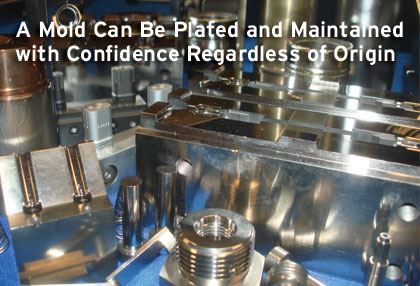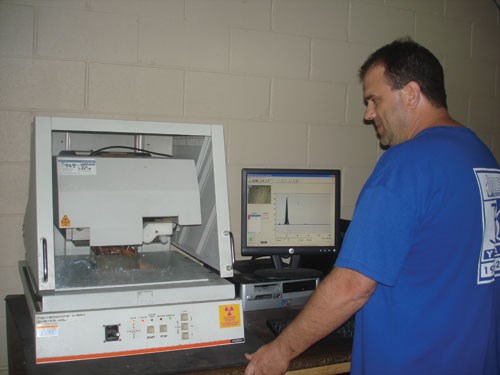It Is What It Is, But What Is It?
With the right tools and experience, a mold can be plated and maintained with confidence no matter where it originated or what materials were used to build it.
Unraveling the mysteries of tooling built overseas and inherited tooling, whether it originates from across the ocean or across the country, is a challenge many shops continue to regularly face. No matter how one might try, it’s sometimes impossible to get the originating shop to provide such useful data as tooling history, mold drawings and diagrams and maintenance records.
There is no doubt that having this information (and more) would make one’s job of getting the tooling into production much easier, but it rarely happens and so the mystery begins. Unless one has the talents of a seasoned detective, it becomes important to have a vendor with the proper equipment or the expertise to uncover clues and solve the tooling mystery.
Experience helps, but it will only get one so far. There is nothing more costly than having to make phone call after phone call—or compose email after email—questioning the owner of the mold about details needed to provide the proper surface treatments.
It is best to avoid making assumptions that can backfire and land the mold back on the repair bench instead of being where it should be: making profits for its owner. So how does one accurately detect the critical details about the tooling that has been delivered into one’s care?
Tell-Tale Tools
How many times have inherited tools shown up on the dock with the customer or previous vendor describing the base metal as “like S-7” or “like H-13” or, worse, “I have no idea”? Gambling on whether it really is “like” what they say can be disastrous, especially when surface treatments are involved.
For example, within a facility that provides surface treatments, every department has a technique or process that must be performed in order to accomplish the job correctly and in a timely manner. If the job requires plating of a stainless steel component, the component will require a longer pre-treatment process and extra steps are required to ensure the component’s surface has good adhesion. Conversely, if the base metal is assumed to be “like stainless steel” and the process is followed, there’s no telling whether the plating material will adhere properly or not, and the customer might not find out until the mold is in production.
Similarly, if polishing a part that is only identified as “like S-7”, but it is really stainless steel, a polisher could hard buff it only to find out the process is causing the base material to pit. When this happens, a secondary process called stoning is then required to restore the surface, taking more time and costing more money.
Stripping of parts for maintenance or restoration of hard chrome plating always requires accurate identification of the base material or much time and money could be spent correcting some big problems.
Many parts can come in already chrome plated, but needing maintenance and the base material was a mystery to the mold owner. We could guess that it was H-13 or S-7, or anything else, but if those parts were stainless and they had gone into the caustic strip solution needed to strip the chrome, the steel would become etched, compromising the parts’ surfaces. Not a good outcome for the customer.
Fortunately there is sophisticated and pricey equipment available for profiling and identifying “mystery metals”— x-ray spectrometer. Through the use of x-ray fluorescence, these devices are capable of accurately analyzing the elements that make up any known or unknown materials.
Whether molds are constructed using chromium, nickel, copper, iron or any combination of these, an x-ray spectrometer breaks down their composition into percentages to help determine if the steel is S-7, H-13, A-2, and so on.
While these machines are limited in terms of the size of the parts that will fit into them for proper detection, today there is also a hand-held device available that performs the same function. By simply pointing its laser at the part, it is capable of analyzing and solving the mystery metal puzzle.
It can also help determine the thickness of a coating, or multiple coatings, on any substrate within millionths, traceable to the standards of the National Institute of Standards and Technology (NIST), which helps to ensure a quality outcome. Note too, that all of this “detecting” is done without the x-ray spectrometer even touching the tool, so there’s no risk of damage to the coating or the mold. Whether the tooling is built in another plant across town or across the globe, x-ray spectrometry can be a very helpful tool in one’s maintenance arsenal.
Summary
It’s clear that it’s never a good idea to blindly apply mold coatings to a tool when the tooling material remains a question mark. In fact, under some ISO guidelines, compliant companies that provide surface treatments are not allowed to do so unless the customer first signs a document verifying what tooling material was used to build the tool. If a guess is made and it’s wrong, the customer better have a flexible budget for correcting the error.
The best advice to take is to either invest in the equipment that will take the mystery out of molds that come through one’s facility, or find a qualified vendor who has the capability and can assist with identifying the clues and laying the mystery to rest, so that whatever surface treatment is desired, it’s done right the first time for optimal production results.
Related Content
Predictive Manufacturing Moves Mold Builder into Advanced Medical Component Manufacturing
From a hot rod hobby, medical molds and shop performance to technology extremes, key relationships and a growth strategy, it’s obvious details matter at Eden Tool.
Read MoreWhat You Need to Know About Hot Runner Systems and How to Optimize Their Performance
How to make the most out of the hot runner design, function and performance.
Read MoreFour Micro Tooling Considerations
Issues involving gating, ejection, mold splits and direction of pull are of special concern when it comes to micro tooling.
Read MoreLaser Welding Versus Micro Welding
The latest battle in finely detailed restoration/repair of mold materials.
Read MoreRead Next
Build-Ups for Maintenance: Benefit or Band-Aid?
When is providing build-ups on tooling appropriate and when is it just a band-aid on a problem that could lead to more extensive repairs later?
Read MoreAre You a Moldmaker Considering 3D Printing? Consider the 3D Printing Workshop at NPE2024
Presentations will cover 3D printing for mold tooling, material innovation, product development, bridge production and full-scale, high-volume additive manufacturing.
Read MoreReasons to Use Fiber Lasers for Mold Cleaning
Fiber lasers offer a simplicity, speed, control and portability, minimizing mold cleaning risks.
Read More













.jpg;maxWidth=300;quality=90)









